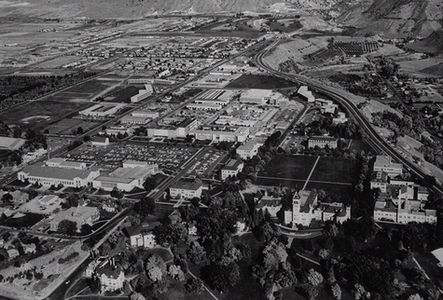UTAH STATE UNIVERSITY

Utah State University, c. 1960
Utah State Agricultural College was established by an act of the Utah Territorial Legislature in March of 1888. After considerable debate and investigation, the legislature selected Logan, in Cache County as the site. A short time later, Jeremiah Sanborn from Missouri accepted the position as Director of the Experiment Station. Sanborn's duties expanded to include the presidency of the college. As Utah's land-grant institution, the college assumed the responsibilities outlined in the 1862 Morrill Land Grant Act; agriculture and mechanical arts comprised the original curriculum.
The school grew steadily and went through numerous name and mission changes. The names include Agricultural College of Utah, Utah Agriculture College, Utah State Agriculture College, and finally in 1957, Utah State University (USU). As state- and federal-sponsored programs developed, USU assumed a primary position throughout the rural Intermountain West. Due to commitments to the experiment station, extension division, and outreach programs, the college attracted thousands of students from rural Utah and surrounding states. The "AC," as it was labeled, literally fulfilled its mission by claiming "the state is our campus."
At various times, the institution faced threats from those concerned that it might become a university. In the early twentieth century legislature passed laws that prohibited Utah State from teaching and training in certain academic areas that would competed with the University of Utah. Nevertheless, the school grew and prospered because of strong federal support and determined faculty, students, and alumni.
During both world wars, the campus served the nation by providing facilities for training troops. This brought considerable diversity to the community as well as needed federal dollars. The student body reached over 3,000 on the eve of World War II, but during the war dropped to less than 1,000. The G.I. Bill and the end of the war caused a dramatic influx of veterans and their families. By 1948, the student body numbered 4,600. There was a gradual decrease into the early 1950s, but there has been steady growth since. The current total enrollment (1992) is in excess of 16,000 students.
Utah State is currently comprised of eight colleges, a graduate school, and numerous support agencies. Although the institution proudly continues its role as the state's land-grant institution, its mission has expanded considerably.
The College of Agriculture exists as a teaching and research division that continues to prepare students and the population to provide foodstuffs. Through close cooperation with the Extension Services, they are able to disseminate knowledge throughout the region. The College of Agriculture also coadministers the Business and Family Life department in order to insure interdisciplinary education for students.
Utah State had one of the first Divisions of Commerce west of the Mississippi. This has evolved into a College of Business that enables students to achieve positions in an expanding national and international marketplace. This college is one of the largest at the university and sponsors numerous programs to enhance communication between the world of business and the campus.
Each of the colleges plays a significant and dramatic part in student preparation. One of Utah State's traditional roles is to train public education teachers for the state. Thousands of teachers are taught and prepared at the university's Emma Eccles Jones Education building. The College of Engineering continues historic role in irrigation, civil, electrical and mechanical engineering, but recently moved into the forefront of space research. Combining with physicists, the Space Dynamics Laboratory at USU is a co-partner with NASA's shuttle program. The College of Science combined with those of Humanities, Arts and Social Sciences to create a nationally acclaimed Liberal Arts and Science undergraduate curriculum. Natural Resources has always been a strong division of USU. Its environmental research has changed conceptions of the world. Finally, the College of Family Life continues another traditional USU role.
These colleges are augmented by a very successful graduate program that enroll nearly 3,000 students; a continuing education program that provides classes through home study, electronic media services, and centers in every corner of the state, and numerous successful support personnel.
The Athletic, Music, and Theater departments offer tremendous artistic opportunities to the region. Possessing first-rate facilities, the University provides both a quality of life and a diverse program. The institution continues to expand its impact by numerous summer workshops and short courses.
Of the current student body, over 80 percent claim Utah residence. Many transferred from out-of-state homes, but achieve residency for economic reasons. Utah State has over l,000 foreign students from in excess of 80 countries. This has been a USU role since the 1950s and provides intercultural awareness. The friendly environment continues in spite of the enrollment growth. Although the University has had thirteen presidents in over one hundred years, its consistency is that it is an excellent academic institution where individuals can achieve their goals and prepare for citizenship in the world.
Disclaimer: Information on this site was converted from a hard cover book published by University of Utah Press in 1994. Any errors should be directed towards the University of Utah Press.